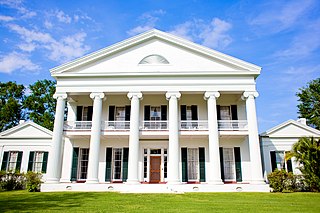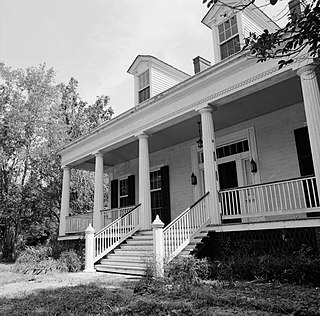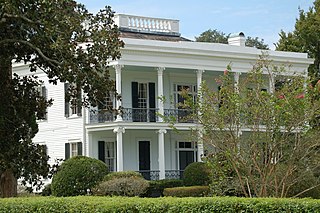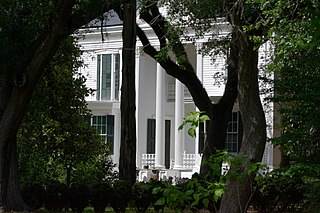
Oak Alley Plantation is a historic plantation located on the west bank of the Mississippi River, in the community of Vacherie, St. James Parish, Louisiana, U.S. Oak Alley is named for its distinguishing visual feature, an alley or canopied path, created by a double row of southern live oak trees about 800 feet (240 meters) long, planted in the early 18th century — long before the present house was built. The allée or tree avenue runs between the home and the River. The property was designated a National Historic Landmark for its architecture and landscaping, and for the agricultural innovation of grafting pecan trees, performed there in 1846–47 by an enslaved gardener.

Madewood Plantation House, also known as Madewood, is a former sugarcane plantation house on Bayou Lafourche, near Napoleonville, Louisiana. It is located approximately two miles east of Napoleonville on Louisiana Highway 308. A National Historic Landmark, the 1846 house is architecturally significant as the first major work of Henry Howard, and as one of the finest Greek Revival plantation houses in the American South.

Berry Hill Plantation, also known simply as Berry Hill, is a historic plantation located on the west side of South Boston in Halifax County, Virginia, United States. The main house, transformed c. 1839 into one of Virginia's finest examples of Greek Revival architecture, was designated a National Historic Landmark in 1969. The surviving portion of the plantation, which was once one of the largest in the state, is now a conference and event center.

Gaineswood is a plantation house in Demopolis, Alabama, United States. It is the grandest plantation house ever built in Marengo County and is one of the most significant remaining examples of Greek Revival architecture in Alabama.

Waverley is a mansion, formerly a plantation house and now a historic house museum, in Clay County, Mississippi, ten miles east of West Point. Built in the 1838, it is architecturally unique among Mississippi's antebellum mansions for its enormous octagonal cupola. It was declared a National Historic Landmark in 1973.

Stanton Hall, also known as Belfast, is an Antebellum Classical Revival mansion at 401 High Street in Natchez, Mississippi. Built in the 1850s, it is one of the most opulent antebellum mansions to survive in the southeastern United States. It is now operated as a historic house museum by the Pilgrimage Garden Club. The house was declared a National Historic Landmark in 1974 and a Mississippi Landmark in 1995.

Evergreen Plantation is a plantation located on the west side of the Mississippi River in St. John the Baptist Parish, near Wallace, Louisiana, and along Louisiana Highway 18. The main house was constructed mostly in 1790, and renovated to its current Greek Revival style in 1832. The plantation's historical commodity crop was sugarcane, cultivated by enslaved African Americans until emancipation.

Rattle and Snap is a plantation estate at 1522 North Main Street in Mount Pleasant, Tennessee. The centerpiece of the estate is a mid-1840s mansion that is one of grandest expressions of the Greek Revival in Tennessee. It was designated a National Historic Landmark in 1971 for its architecture, and for its association with the Polk family, once one of eastern Tennessee's largest landowners. The house is privately owned, but may be viewed by appointment.

Millford Plantation is a historic forced-labor farm and plantation house located on SC 261 west of Pinewood, South Carolina. It was sometimes called Manning's Folly, because of its remote location in the High Hills of Santee section of the state and its elaborate details. Designated as a National Historic Landmark, it is regarded as one of the finest examples of Greek Revival residential architecture in the United States. The house has been restored and preserved along with many of its original Duncan Phyfe furnishings.

Rose Hill Plantation State Historic Site is a historic site in Union County, South Carolina, that preserves the home of William H. Gist (1807-1874), the 68th governor of South Carolina. Gist helped instigate a Secession Convention in South Carolina, which led to the creation of the Ordinance of Secession that preceded the Civil War.

Ashland Plantation, also known as the Belle Helene or Ashland-Belle Helene Plantation, is a historic building, built in 1841, that was a plantation estate and home of Duncan Farrar Kenner. Located in Darrow, Louisiana, in Ascension Parish. The manor house is an example of antebellum Greek Revival architecture.

Rienzi Plantation House is a historic mansion located at 215 East Bayou Road in Thibodaux, Louisiana.

The Brattonsville Historic District is a historic district and unincorporated community in York County, South Carolina. It includes three homes built between 1776 and 1855 by the Brattons, a prominent family of York County. It was named to the National Register of Historic Places in 1971.

The Bagatelle Plantation is a Southern plantation with a historic mansion in Sunshine, Louisiana, USA.

The Battleground Plantation is a Southern plantation with a historic mansion located about 3.2 miles (5.1 km) north of the town of Sicily Island in Catahoula Parish, Louisiana. It was listed on the National Register of Historic Places in 1979.

The St. Louis Plantation is a Southern plantation with a historic mansion located in Iberville Parish, Louisiana, United States.

The Cliffs Plantation is a Southern plantation with a historic mansion located in Natchez, Mississippi, USA.
Charles B. Cluskey was an American architect active from the 1830s to the start of the Civil War, and therefore he is recognized as an antebellum architect. He is reputed to be the initiator of the Greek Revival–style in the south, and his commissions, both public and private, can still be seen in Augusta, Milledgeville and Savannah, Georgia.

Birdsville Plantation, in Birdsville, Jenkins County, Georgia near Millen, is a 50 acres (20 ha) property which was listed on the National Register of Historic Places in 1971. It then included 10 contributing buildings. It is a National Bicentennial Farm.

The Miller Plantation House is a historic mansion in Olive Branch, Mississippi. It was built in 1849 for William Lord Miller, a planter. It was designed in the Greek Revival architectural style, and its large size was unusual for its remote location. It has been listed on the National Register of Historic Places since July 15, 1982.




















